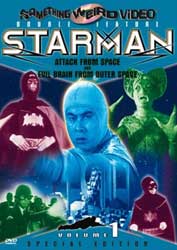 Japan's first cinematic superhero was for the matinee serial type series Super Giant (Supa Jaiantsu, 1956-59), the hero also being known as the "Giant of Steel" (Kotetsu no kyoji), played by Ken Utsui. Japan's first cinematic superhero was for the matinee serial type series Super Giant (Supa Jaiantsu, 1956-59), the hero also being known as the "Giant of Steel" (Kotetsu no kyoji), played by Ken Utsui.
Super Giant wasn't literally a giant, except in strength & heroism, patterned mainly on Superman (1952-1958), the George Reeves series in America having been airing on Japanese television with considerable influence.
One big difference between Superman & Supa Jaiantsu is that George Reeves had to have his crotch taped flat since getting a woody while in tights would not be appropriate for a children's show, whereas Ken Utsui had his codpiece stuffed with cotton as Japanese didn't fancy a super hero who was dickless or even just normally hung.
Although superheros of the American comic book variety had been appearing in Japan for a couple of decades in manga comic book form, such a hero waited until 1956 for Japanese cinema to present such a figure in the movie houses, & until 1957 for the first costume superhero to appear on Japanese television.
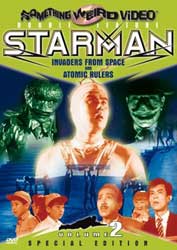 Starman looks like a normal Japanese guy when not in his costume, but he was actually manufactured out of "the strongest steel" on the planet Emerald. The High Counsel of the planet Emerald is a peace-enforcing court that uses Super Giant primarily as their representative of peace on Earth, an exemplar of gunboat diplomacy, & a little like another American comic book hero, Green Lantern. Starman looks like a normal Japanese guy when not in his costume, but he was actually manufactured out of "the strongest steel" on the planet Emerald. The High Counsel of the planet Emerald is a peace-enforcing court that uses Super Giant primarily as their representative of peace on Earth, an exemplar of gunboat diplomacy, & a little like another American comic book hero, Green Lantern.
He gets several powers from his wristwatch-like Globe Meter (rather than from a ring like Greek Lantern), which the Counsel gives him before each assignment. In between assignments we must suppose he lives a comparatively mundane life on Emerald since he doesn't get to keep the watch. He'd be great for directing traffic since if a jet-car accidentally ran over him, he's made of steel.
The American distributor re-edited & dubbed all nine episodes into four movies, telling stories a bit different than in the Japanese originals, & renaming Super Giant "Starman."
Of the original nine mini-movies, six were "two parters" telling one story each, so were quickily editable into three films. The last three episodes were independent stories, however, & were rather more cut & mucked with to make the fourth English language film.
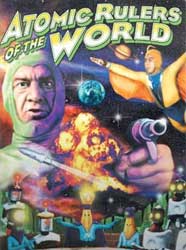 The first in the set is Atomic Rulers of the World or just The Atomic Rulers (1964), combining the first two mini-films, "Super Giant" (Supah Jaianto, 1957) & "Super Giant Continues" (Zoku Supah Jaianto,1956). Nineteen minutes were trimmed out, & changes in plot were imposed in English, which may be why some of the logic of the whole seems to be missing, not that it necessarily made much sense in Japanese either. The first in the set is Atomic Rulers of the World or just The Atomic Rulers (1964), combining the first two mini-films, "Super Giant" (Supah Jaianto, 1957) & "Super Giant Continues" (Zoku Supah Jaianto,1956). Nineteen minutes were trimmed out, & changes in plot were imposed in English, which may be why some of the logic of the whole seems to be missing, not that it necessarily made much sense in Japanese either.
Stock footage of atomic bomb tests & explosions are shown immediately, which for a children's story screened so close to the bombing of Hiroshima & Nagasaki must've been damned scary. The radiation, we're informed, is contaminating outer space, so that even distant planets in other solar systems are threatened. The High Counsel of the Planet Emerald has gotten together in their outdoor crater-arena to discuss the situation on Earth.
All four films include an opening scene with the same footage of the High Counsel of the Emerald Planet, each time discussing the latest emergency occurring on Earth. We don't hear their alien conversations, however, as it's always a voice-over explains why Starman is needed on Earth this time.
The High Counsel are "creatures of peace," who enforce peace throughout the Moth-head Galaxy where a number of races are far less noble of intent. Among the members of the counsel are several five-pointed star-shaped beings also encountered in Warning from Space (1956). Some of the Emerald Counsel aliens look rather robotic.
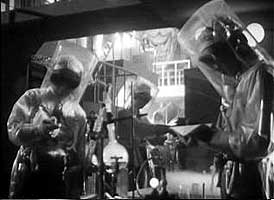 The Counsel members hardly seem likely to be all from the same planet of Emerald, since they're the wackiest & most varied group of cardboard & sewn-cloth costumes ever put together by excited fans for a Sci-Fi Convention. The Counsel members hardly seem likely to be all from the same planet of Emerald, since they're the wackiest & most varied group of cardboard & sewn-cloth costumes ever put together by excited fans for a Sci-Fi Convention.
The nation of Megolia on Earth is about to take over the whole planet, so the Emerald hiearchy gives the Globe Meter to Starman, who flies to Earth in order to force peace on the world. He soon saves an orphan boy & interacts with other children as the film progresses, including some kids who unfortunately get their mits on a Megolian nuclear weapon.
Although a mite difficult to make much sense out of, eventually Starman succeeds at stopping the Megolians from using their more destructive nuclear devices. One atomic bomb, however, does go off in a small chamber, with Starman & some children in it. Starman protects the children by placing his body on the bomb, & simultaneously blows their way out of the metal room. Apparently Megolian atomic mega bombs are the equivalent of about a fifth of a stick of dynamite.
The other three films in the series are more surreal with space invaders & really bizarre judo-fighting monster people of sundry sorts & many bizarre though cheap sets. This first film is more down-to-earth, more about scrapes & escapes.
A head-chopping machine for instance works in slow motion so that Starman has loads of time to save the beautiful Perils-of-Pauline heroine. The climax has Starman's phony judo defeating everybody bad who works in a nuclear submarine cave-base.
The nation of the Megolians seems to be named after Mongolia, which isn't nice since the Japanese waged a very cruel war against Mongolia a couple decades before. But the Megolians with their nuclear weapons are played by Caucasians, obviously because the people who actually did drop atomic bombs on two Japanese cities remain to this day the only nation ever to have used nuclear weapons in wartime, against civillians or otherwise. Too bad Starman didn't show up just a wee bit sooner.
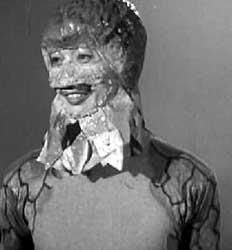 The second Starman movie was made up from Super Giant, #3 "Mysterious Spacemen's Demon Castle" (Kotetsu no kyojin: Kaiseijin no majyo, 1957) & #4 "Earth on the Verge of Destruction" (Kotetsu no kyojin: Chikyu metzubo sunzen, 1957). The second Starman movie was made up from Super Giant, #3 "Mysterious Spacemen's Demon Castle" (Kotetsu no kyojin: Kaiseijin no majyo, 1957) & #4 "Earth on the Verge of Destruction" (Kotetsu no kyojin: Chikyu metzubo sunzen, 1957).
The two episodes told a single continuous story so not much fudging was necessary to make them into a single film, Invaders from Space (1964).
This film occasionally appears on lists of films as an alternate title for the too-similarly named Attack from Space, but that one's made up of entirely different Super Giant episodes.
Kappa are traditional Japanese mythological creatures part water-sprite & part vampire. The invading Kappa-seijin are the alien equivalent.
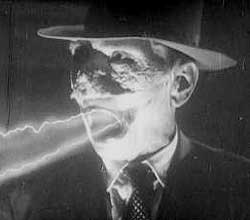 In the English translation they become "salamander men" who've invaded the Earth from the planet Kulamon, coming all the way from the Marpet galaxy. In the English translation they become "salamander men" who've invaded the Earth from the planet Kulamon, coming all the way from the Marpet galaxy.
The same film footage from the first film is used for the narrated opening High Counsel of Planet Emerald, explaining the current emergency & the powers bestowed by the Globe Meter.
Then Starman sets off for Earth, for what is arguably the best adventure in the whole set, if by "best" one means wackiest & strangest looking.
Encountering the best array of super-villains yet, this one has strong kid appeal, with Starman enlisting children in his fight against the invaders.
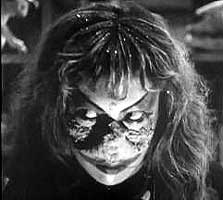 A few bits are nightmarish enough that the youngest or oversensitive kids might need coddling afterward. The saucer invaders have established an undersea base, & are unleashing a virulent disease upon the earth. A few bits are nightmarish enough that the youngest or oversensitive kids might need coddling afterward. The saucer invaders have established an undersea base, & are unleashing a virulent disease upon the earth.
An evil nurse who turns into a mush-nosed demoness is especially ferocious & should startle the wee ones, though happily the children themselves visit upon her a Margaret Hamilton demise.
It is also admirable for imaginative make-up & costumes on the cheap. The most elaborate effect would be the salamander man nuclear halitosis. The most effectively campy would be the dance choreography of the Yamano Theater.
Even Starman's judo techniques aren't enough to eradicate the alien swarm, but a newly invented salamander-killing gun can do the trick.
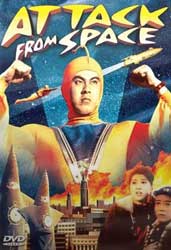 Attack from Space (1964) is made up from two episodes of the children's mini-film series Super Giant, namely the entirety of episode 5 "Artificial Satellite's Destruction of Earth" (Uchutei to jinko eisen no kekitotsu, 1958) & episode 6 "Space Ship's Clash with the Artifical Satellite" (Jinko eisen to jinrui no hametsu, 1958). Attack from Space (1964) is made up from two episodes of the children's mini-film series Super Giant, namely the entirety of episode 5 "Artificial Satellite's Destruction of Earth" (Uchutei to jinko eisen no kekitotsu, 1958) & episode 6 "Space Ship's Clash with the Artifical Satellite" (Jinko eisen to jinrui no hametsu, 1958).
This time with that recurring opening footage of the Emerald Men's High Counsel, the voice-over informs that the unpeaceful conquering Superions are about to attack the Earth, as stage one of their plan to take over the whole galaxy.
The Counsel calls forth Starman, gives him the Star Globe so he can fly between planets, & off he goes through deep space toward that humble little planet which so many bad aliens wish was theirs.
Like all the Starman movies, this is strictly a children's film. I'd've been delighted by it when I was about seven, probably way too old for it by the time I was nine.
On adult viewing, I can force my mind into a nostalgic perspective when Buck Rogers, Flash Gordon, & Captain Video could actually be mistaken as realistic by a child seeing them for the first time in days of black & white boob-tube time fillers.
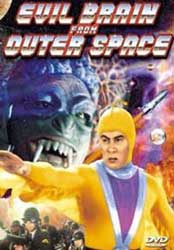 This particular film has enough wacky stuff happening on crazily designed sets that it would be absolutely wonderful projected on the wall of a dimlit dance club, the film's soundtrack turned off, replaced with a d-j spinning techno music. I can't think of another context where anyone but wee children, & fans of the crappiest of crappy films, would delight in anything so cheap & silly. This particular film has enough wacky stuff happening on crazily designed sets that it would be absolutely wonderful projected on the wall of a dimlit dance club, the film's soundtrack turned off, replaced with a d-j spinning techno music. I can't think of another context where anyone but wee children, & fans of the crappiest of crappy films, would delight in anything so cheap & silly.
The fourth & final Starman film Evil Brain from Outer Space (1964) was edited from three Supa Jaiantsu episodes: number 7 "Space Mutant Appears" (Uchu kaijin shutsugen, 1958); number 8 "Devil's Incarnation" (Dokuga okuku, 1959); & the final episode 9 "Poison Moth Kingdom" (Akuma no keshiin, 1959).
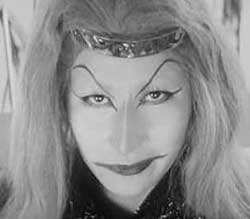 Teruo Ishii left the original series as director when a child imitating Super Giant put on a cape & leapt from a window to his death. The last three episodes had two other directors. Teruo Ishii left the original series as director when a child imitating Super Giant put on a cape & leapt from a window to his death. The last three episodes had two other directors.
It may be that Ken Utsui was also traumatized by the child's death, as he never afterward would answer any reporter or film & popular culture historians' questions about this his most famous role.
The last three episodes were distinct stories & did not combine & condense as rationally (rationally! ha!) as the first three films which were made each from two-part episodes.
For the fourth film, too much footage was discarded. All four films are a bit muddled, but this one is chaotic, though assuredly action-packed.
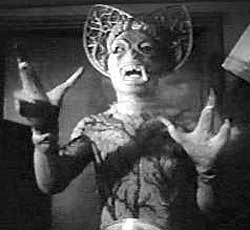 The Star Counsel again convenes with the same footage as always, the narrator explaining how the evil space-tyrant Balisar was about to die when he had his brain put into a machine (more like a belljar) that would keep him forever alive. The Star Counsel again convenes with the same footage as always, the narrator explaining how the evil space-tyrant Balisar was about to die when he had his brain put into a machine (more like a belljar) that would keep him forever alive.
Balisar's brain is now on Earth fomenting war, with the intent of triggering nuclear warfare so awful it will poison the whole universe, while developing germs that will kill all humanity.
The first scenes on Earth show a man pursued by night along film noir streets until captured by policemen who cause him to drop his briefcase in a river, calling out, "The brain! The brain!"
This moody sequence is I'm pretty sure taken from some other movie I've seen, but I can't remember which one. The comparatively cool noir cinematography is not sustained in the rest of the film.
Starman destroys a germ factory & all sorts of silly heroics, including a couple of his signature one-against-all judo battles in which he occasionally stops fighting to flex his muscles with both arms held upward, Starman's equivalent of Superman with fists on hips.
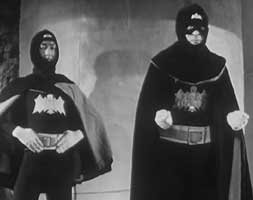 The germ warfare people are called the Zumarians & dress rather like Batman with the bat symbol on their chests. Some mutant Zumarian soldiers dress like the Green Hornet complete with Lone Ranger masks. The germ warfare people are called the Zumarians & dress rather like Batman with the bat symbol on their chests. Some mutant Zumarian soldiers dress like the Green Hornet complete with Lone Ranger masks.
Quite a strange array of comic book type alien super-villains are involved in fights with Starman: A man in big sunglasses with a hook for a hand is the most "normal" of the lot.
There's also a kabuki demoness that manifests from a belljarred brain that looks exactly like Balisar's brain but isn't.
She has long black nails & can shoot nuclear fire from her body. When she is flnally blown up because of the nuclear energy inside her, it's curious that nobody standing in the vicinity is injured.
Then there's the scarfaced evil scientist who does Balisar's bidding since Balisar hasn't a body of his own; & a mutant Zumarian karate fighter with big funny webbed mouse ears (a moth-man in the Japanese original).
Starman's final deed is finding the hiding place of Balisar's brain, which looks like a pulsating dirty washrag, so that the belljar can be lifted off him & a special toxin dumped on the rag. Doncha love a happy ending?
copyright © by Paghat the Ratgirl
|
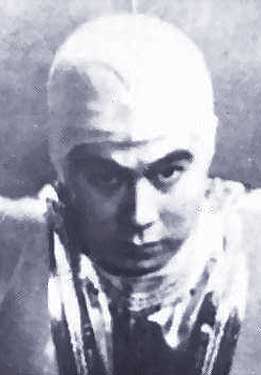

 Starman looks like a normal Japanese guy when not in his costume, but he was actually manufactured out of "the strongest steel" on the planet Emerald. The High Counsel of the planet Emerald is a peace-enforcing court that uses Super Giant primarily as their representative of peace on Earth, an exemplar of gunboat diplomacy, & a little like another American comic book hero, Green Lantern.
Starman looks like a normal Japanese guy when not in his costume, but he was actually manufactured out of "the strongest steel" on the planet Emerald. The High Counsel of the planet Emerald is a peace-enforcing court that uses Super Giant primarily as their representative of peace on Earth, an exemplar of gunboat diplomacy, & a little like another American comic book hero, Green Lantern.
 The Counsel members hardly seem likely to be all from the same planet of Emerald, since they're the wackiest & most varied group of cardboard & sewn-cloth costumes ever put together by excited fans for a Sci-Fi Convention.
The Counsel members hardly seem likely to be all from the same planet of Emerald, since they're the wackiest & most varied group of cardboard & sewn-cloth costumes ever put together by excited fans for a Sci-Fi Convention.
 In the English translation they become "salamander men" who've invaded the Earth from the planet Kulamon, coming all the way from the Marpet galaxy.
In the English translation they become "salamander men" who've invaded the Earth from the planet Kulamon, coming all the way from the Marpet galaxy. A few bits are nightmarish enough that the youngest or oversensitive kids might need coddling afterward. The saucer invaders have established an undersea base, & are unleashing a virulent disease upon the earth.
A few bits are nightmarish enough that the youngest or oversensitive kids might need coddling afterward. The saucer invaders have established an undersea base, & are unleashing a virulent disease upon the earth.
 This particular film has enough wacky stuff happening on crazily designed sets that it would be absolutely wonderful projected on the wall of a dimlit dance club, the film's soundtrack turned off, replaced with a d-j spinning techno music. I can't think of another context where anyone but wee children, & fans of the crappiest of crappy films, would delight in anything so cheap & silly.
This particular film has enough wacky stuff happening on crazily designed sets that it would be absolutely wonderful projected on the wall of a dimlit dance club, the film's soundtrack turned off, replaced with a d-j spinning techno music. I can't think of another context where anyone but wee children, & fans of the crappiest of crappy films, would delight in anything so cheap & silly. Teruo Ishii left the original series as director when a child imitating Super Giant put on a cape & leapt from a window to his death. The last three episodes had two other directors.
Teruo Ishii left the original series as director when a child imitating Super Giant put on a cape & leapt from a window to his death. The last three episodes had two other directors. The Star Counsel again convenes with the same footage as always, the narrator explaining how the evil space-tyrant Balisar was about to die when he had his brain put into a machine (more like a belljar) that would keep him forever alive.
The Star Counsel again convenes with the same footage as always, the narrator explaining how the evil space-tyrant Balisar was about to die when he had his brain put into a machine (more like a belljar) that would keep him forever alive. The germ warfare people are called the Zumarians & dress rather like Batman with the bat symbol on their chests. Some mutant Zumarian soldiers dress like the Green Hornet complete with Lone Ranger masks.
The germ warfare people are called the Zumarians & dress rather like Batman with the bat symbol on their chests. Some mutant Zumarian soldiers dress like the Green Hornet complete with Lone Ranger masks.